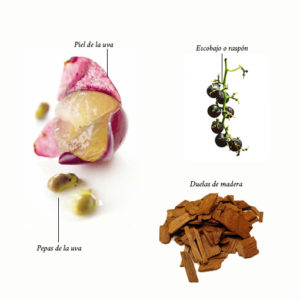Tannins in red wine provide a dry, slightly tart, astringent mouthfeel. But what exactly are tannins? Are tannins found in every wine? How do they taste? At iberoWine we answer all your questions.

What are tannins in wine and what do they do?
As a wine lover, you may already be familiar with tannins (also known as tannins), especially if you enjoy drinking red wine. Tannins themselves are tasteless and odorless. However, if you experience a bitter, dry, furry mouthfeel (known as an astringent or astringent sensation) after drinking wine, especially red wine, it’s because tannins interact with the proteins in saliva.
But apart from this taste experience, do you know what these vegetable tanning agents are and what their function is? It may surprise you to learn that tannins are of great importance for the quality of red wine production. Therefore, winemakers use different techniques and methods to extract just the right amount and make the best possible wine.
What are tannins?
Tannins are natural compounds (polyphenols) found in plants, trees and fruits. These vegetable tannins bind oxygen in the wine, preserve the aromas, influence the storage potential and prevent oxidation.
It is believed that the development of tannins in nature is a defense against eating fruit that is underripe. You’ve probably spotted tannins not only in wine, but also in chocolate, black tea, and even certain nuts. In addition to these edible foods, tannins are also found in leaves, stems, bark, wood, and many other parts of plants. These tannins can be used to tan leather, dye textiles, and produce adhesives, as well as being used to create more complex and interesting foods and beverages.
Tannin in winemaking
Tannins in winemaking come from a variety of sources, including grape skins, stems, pits, and even oak barrels. Controlling all of these potential sources of tannins is one of the most important tasks of the winemaker. Different grape varieties have different levels of tannin. Tempranillo, for example, has a higher tannin content while Garnacha has a lower percentage, partly because the grape skin is thinner and releases fewer tannins during pressing and maceration. In addition, the growing conditions of each year affect the tannin content of the grapes, which varies from vintage to vintage.
Speaking of production stages, red wines are typically harvested, pressed, and macerated to extract all of the aroma and color needed to produce a premium wine. Depending on the wine and the winemaker’s goals, pits and stems may be retained during this process to achieve higher tannin levels. The quality of these tannins also varies depending on the origin, so the know-how of the winemaker is crucial to achieve the desired result.
Interesting facts:
– New wooden barrels tend to yield more tannins to the wine.
– higher content of tannins, the longer the wine will be preserved.
– The more tannic acid a red wine contains, the hotter it can be drunk.
– tannins act as a natural antioxidant that protects the wine from bacteria.
Do white wines have tannins?

Interestingly, white wine also contains tannins, but usually in lower concentrations, so that they tend to go unnoticed compared to red wine. This is due to an important difference in the winemaking process, because in the production of white wine there is usually little or no maceration after the grapes have been pressed. This lack of mash fermentation removes important sources of tannin from the process. Some maceration is allowed for rosé wines, as this process gives the red wine grape skins the color necessary for the pink color of the wine.
Does aging in oak reduce tannins?
The oak barrels used in winemaking contribute significantly to the tannin content of a wine and must be taken into account during production. The age of the barrels determines how many oak tannins are in the wine. If new casks are used, a strong and robust wine should be chosen so that the oak tannins do not take over.
Which foods go best with tannic wines?
Because tannins are a chemical compound, their reaction on the palate is also chemical. As mentioned earlier, they interact with proteins in our saliva, allowing us to recognize and perceive them in everything we eat. The reaction of tannins with proteins is one of the reasons why we enjoy red wines with foods like red meat, game, cheese and other fatty foods. The tannins tend to react well with such foods and allow other, more subtle characteristics of the wine to come into their own.
Tannins are the elements in wine that provide the astringency and liveliness that we expect from red wines. Whether you like a wine with more or less tannin is really a matter of taste and personal preference. Tempranillo, Garnacha, and Cabernet Sauvignon are examples of higher tannin wines, while Pinot Noir, Garnacha, and Bobal tend to be lower in tannins. It should not be forgotten that tannins are an important part of the winemaking process and the way they are reflected in the glass from which the wine is drunk is a testament to the skill and ability of the winemaker.